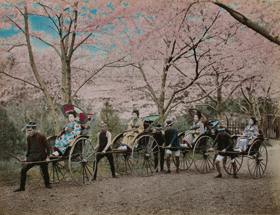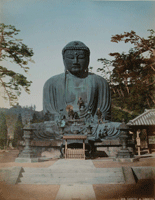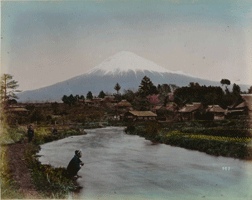 Part1:To the East Travel and photography in the 19th century Photographer unknown, CHERRY BLUSSOMS AND JINRIKISHAS, JAPAN, 1870-90, Hand colored albumen print It was introduced to the newspaper Article is here |
|
Part1:To the East
Travel and photography in the 19th century
May. 16—Jul. 12, 2009
- May. 16—Jul. 12, 2009
- Closed Monday (Tuesday if Monday is a national holiday)
- Admission:Adults ¥500(400)/College Students ¥400(320)/High School and Junior High School Students, Over 65 ¥250(200)
Travel and photography have been closely intertwined from the dawn of photography in the nineteenth century. Since the camera and photographic process reached Japan’s shores in the closing years of the Tokugawa shogunate, travel-related photography, undertaken from many perspectives, has proliferated. The Travel exhibition explores works in a wide variety of styles through three approaches with distinct points of view, unfolding in a three-part series over the course of about six months.
1. The Invention of the Photographic Process
“And this led me to reflect on the inimitable beauty of the pictures of nature’s painting which the glass lens of the Camera throws upon the paper in its focus—fairy pictures, creations of a moment, and destined as rapidly to fade away. “It was during those thoughts that the idea occurred to me . . . . . how charming it would be if it were possible to cause these natural images to imprint themselves durably, and remain fixed on the paper!” William Henry Fox Talbot, The Pencil of Nature, Vol. 1, 1844. In 1833, William Henry Fox Talbot traveled on his honeymoon to Lake Como, in Italy. It was then that he had the idea of fixing the image that the camera obscura produced. Travel was the inspiration for the birth of the photographic process.
2. New Mode of Travel
The act of looking at daguerreotypes was a totally new visual experience. In France, Nöel Paymal Lerebours commissioned people with the necessary equipment to take daguerreotypes of famous tourist destinations throughout the world. The resulting images were traced and converted into copper plates for publication as the series Excursions daguerriennes. In a world when it was still not possible to print photographs as we do today, the “based on a daguerreotype” credit on an image, even if that image were drawn by hand, transformed it into a device delivering a virtual experience of world travel from the comfort of home.
3. The Photographic Process Joins the Grand Tour
The tradition of the Grand Tour, of travel to educate and refine the sons of the nobility through personally encountering the classics of European culture, began in the latter half of the sixteenth century in Britain. By the nineteenth century, with advances in transportation, the custom had developed into pleasure trips for members of the upper class--the genesis of modern tourism. The camera came to play a vital role as a tool for recording those travels. William Henry Fox Talbot’s friends Calvert Richard Jones, George Wilson Bridges, and William Robert Baker all traveled to Italy equipped with cameras and supplies for photographing, using the calotype process. Their passionated engagement with photography has given us a lasting record: visual memories of their experiences.
4. To the East
In the nineteenth century, Orientalism, a yearning for the East, became widespread, and many photographers set of for the Near East and beyond. Photographic journeys to Egypt inspired by archeological interests, such as those by Maxime Du Camp and August Saltzmann, aroused even greater interest in the Orient, thanks to the sense of its reality their photographs communicated. Even more photographers then set off on journeys with their cameras. Photographers such as Antonio Beato and Bonfils settled in the Near East and made documenting what they saw their life’s work. Creating and selling albums of their work, they gave the world images filled with exoticism.
5. To Asia
Having traveled to the Orient, the photographic process continued on its journey, reaching Southeast Asia and then China, fueled by the ever-expanding ambitions of “image hunters.” John Thomson photographed the landscapes and peoples of China from a cultural, anthropological point of view. William Saunders and Pierre Joseph Rossier traveled in China and Japan as special correspondents for the Illustrated London News and for the photographic firm Negretti and Zambra. The photographs of China that they produced include many that went beyond Orientalism to present the realities of China at the end of the Qing dynasty. Their approach to photography might well be called photo-journalism.
6. And on to Japan
In the closing years of the Tokugawa shogunate, Japan was rattled by the opening of the country to foreign trade and calls to expel the barbarians. It was then that the photographic process reached Japan and took root here. Felice Beato, who has been termed “a nineteenth-century photo-journalist,” came to Japan during those turbulent times and photographed sights, customs, and events throughout the country. He both supplied his work to the British media and began producing albums for sale to tourists. Beato’s photographs were pictorial in style yet consistently driven by a documentary approach worthy of a photo-journalist. After the start of the Meiji Era, the number of foreign tourists visiting Japan increased steadily, and souvenir albums of what were called “Yokohama photographs,” hand tinted prints bound in albums with lacquer covers lavishly decorated in gold and silver makie, were popular souvenirs. The images they contain, which could easily be mistaken for color photographs, show us Westerners’ images of Japan, yet these photographs also are rich in content that records the realities of Meiji Japan.
7. The Imperial Tour in Western Districts
In May, 1872, the Meiji Emperor set out from Tokyo for Ise, Kyoto, Osaka, Nagasaki, and then Kagoshima, for his first journey through the country since the Meiji Restoration in 1868. The photographer Uchida Kuichi took part in the emperor’s trip and later organized the resulting images in an album. What Uchida photographed was not the emperor on tour but rather the scenes that the emperor himself viewed. These photographs, presenting the emperor’s gaze,transformed the act of viewing the country into an event.


Part1:To the East
Travel and photography in the 19th century
Photographer unknown, DAIBUTSU at KAMAKURA, JAPAN, 1870-90, Hand colored albumen print
KUSAKABE Kinbei, Fujiyama From Omiya Village, KUSAKABE Kimbei Album, 1880-90, Hand colored albumen print


![チラシ1[pdf]](http://topmuseum.jp/upload/4/91/thums/2009_006_part1.png)
![出品作品リスト4[pdf]](http://topmuseum.jp/upload/4/91/thums/collection4.png)
![出品作品リスト3[pdf]](http://topmuseum.jp/upload/4/91/thums/collection3.png)
![出品作品リスト2[pdf]](http://topmuseum.jp/upload/3/90/thums/collection2.png)
![出品作品リスト1[pdf]](http://topmuseum.jp/upload/4/91/thums/2009_part1en_list.png)